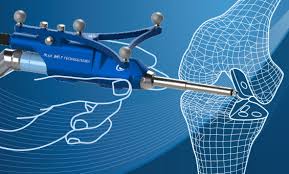 Analyst: Uptake for robotic knee procedures will depend more on marketing than evidence (MassDevice)
Analyst: Uptake for robotic knee procedures will depend more on marketing than evidence (MassDevice)
The adoption of robot-assisted total knee replacements will depend more on marketing that data or outcomes, Leerink Partners analysts wrote yesterday, as the leading contenders prepare to unveil their robotic total knee systems at an upcoming orthopedics conference.
Based on a conference call with a pair of orthopedic surgeons who each perform roughly 200 knee cases annually, the Leerink analysts said their experts believe the gain from robotic technologies will be incremental at best.
“While robotics could improve technique for ‘lower quality’ surgeons, both specialists expressed doubt as to whether the evidence would ever bear out in favor of robotics. Rather, in their minds, it is the ability to attract new patients to the hospital that will make or break robotic adoption,” analysts Richard Newitter and Ravi Misra wrote in a March 2 note to investors. “In their view the appeal of robotics to patients is more around the concept than brand (i.e., robotics vs. MAKOplasty or BlueBelt or “Omniplasty”) and thus [the] specialists believe that ultimately they will be able to pull in patients by advertising ‘robotics’ vs. a particular robotic platform.”
That said, the analysts wrote, the marketing edge belongs to centers in more-affluent cities where patients will seek out providers that offer robotics. More rural settings offer little or no choice of provider or are far from places that might offer robotics, according to the note. But the doc-shopping patients in the more affluent areas could swing 15% to 20% of the market to robotics, Newitter and Misra wrote.
Stryker (NYSE:SYK), which was the 1st major ortho player to get into robotics with the $1.7 billion purchase of Mako Surgical in December 2013, is still the leader of the pack, with Smith & Nephew (NYSE:SNN) and its $275 million Blue Belt acquisition following close behind. Both companies are expected to debut their total knee solutions at the annual meeting of the American Academy of Orthopedic Surgeons in San Diego this month.
The analysts said their experts say Stryker and Smith & Nephew are likely to take market share “at the expense of ‘have-nots’” such as Zimmer Biomet (NYSE:ZBH) and Johnson & Johnson (NYSE:JNJ), but the “adoption curve may be more gradual than hockey-stick-like.”
“Both specialists agreed that if ZBH or JNJ were to launch a robotics platform or acquire one of the private ones, they likely would be able to fend off mkt share loss and participate in any shift to robotics that is set to occur in the marketplace,” the analysts wrote.
“SYK/MAKO [is] clearly the iconic robot brand today, but barriers-to-entry may be lower than appreciated; other systems and competitive response from non-robotics players bear watching,” Newitter and Misra wrote. “Specialists agreed that right now SYK/MAKO is the platform to beat (followed by SNN/BlueBelt) given a strong first mover advantage and fact that an experienced player such as Stryker ‘struck first’ and is now behind the initial robotics push into total knees.”
However, that edge will dissipate over time, they wrote, and Zimmer Biomet and J&J could gain on the flip side of the coin: Hips.